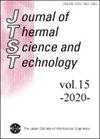时变角度旋流叶片对预混火焰往复传播的影响
IF 1.2
4区 工程技术
Q3 THERMODYNAMICS
引用次数: 0
摘要
测量了未燃烧条件下的流场,明确了涡芯的进动(Shtork et al., 2007)。采用数值模拟方法对实际燃气轮机燃烧室发生的涡击穿进行了分析(Turrell et al., 2004)。精益预混燃烧有望减少高温面积和NOx排放。但是,由于火焰传播,它有闪回的危险。它可以被认为是调节气体涡流强度,以防止闪回和稳定燃烧。本文研制了内径为56 mm,外径为70 mm的时变角度旋流叶片,由36个叶片组成,每个叶片直接与步进电机相连,在保持一定的空气比和流量的情况下,可以周期性地改变旋流强度。我们用高速摄像机确认了旋流叶片角度的周期性运动。通过旋流叶片角度的周期性变化,可以实现火焰位置的上下往复运动。随着叶片角度的增大,火焰向上游运动时,火焰尖端出现上游方向流动;随着叶片角度的减小,火焰向下游运动时,火焰尖端出现下游方向流动。当火焰从上游向下游传播时,火焰尖端附近的上游流动减弱。在火焰从上游向下游传播之前,火焰尖端附近的轴向速度由减小变为增大。本文章由计算机程序翻译,如有差异,请以英文原文为准。
Reciprocating propagation of premixed flame using time-variable-angle swirl vanes
The flow fields under unburned conditions were measured and the precession movement of the vortex core was clarified (Shtork et al., 2007). Numerical simulation was applied to analyze vortex breakdown, which occurred in an actual gas turbine combustor (Turrell et al., 2004). Abstract Lean premixed combustion can be expected to reduce the high-temperature area and NOx emission. However, it has a risk of flashback due to flame propagation. It can be thought to modulate the gas swirl intensity to prevent flashback and to stabilize combustion. In this research, we developed time-variable-angle swirl vanes which had 56 mm of the inner diameter, 70 mm of the outer diameter and consisted of 36 vanes, each vane was directly connected to a stepping motor, and the swirl intensity could be changed periodically by keeping the constant air ratio and flow rate. We confirmed the periodical movement of the swirl vane angle using a high-speed camera. The flame position could be made reciprocating move upstream and downstream by the periodic change of the swirl vane angle. The upstream direction flow at the tip of the flame appeared when the flame moved in the upstream direction with increasing vane angle and the downstream direction flow appeared when that moved in the downstream direction with decreasing the vane angle. When the flame propagation was changed from upstream direction to downstream, the upstream direction flow near the flame tip was weakened. In advance of changing the flame propagation from upstream direction to downstream, the axial velocity near the flame tip changed from decreasing to increasing.
求助全文
通过发布文献求助,成功后即可免费获取论文全文。
去求助
来源期刊
CiteScore
2.30
自引率
8.30%
发文量
0
审稿时长
5 months
期刊介绍:
JTST covers a variety of fields in thermal engineering including heat and mass transfer, thermodynamics, combustion, bio-heat transfer, micro- and macro-scale transport phenomena and practical thermal problems in industrial applications.

 求助内容:
求助内容: 应助结果提醒方式:
应助结果提醒方式:


